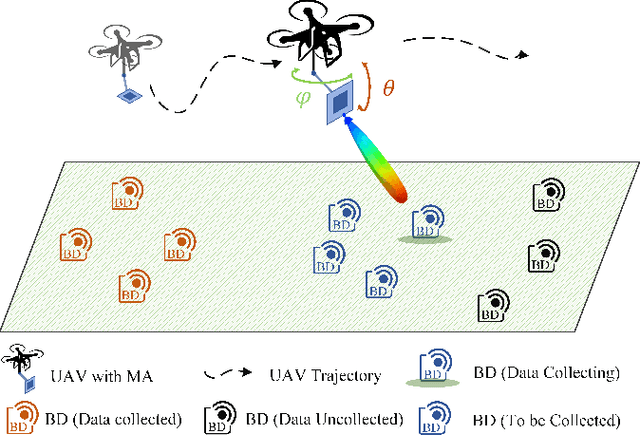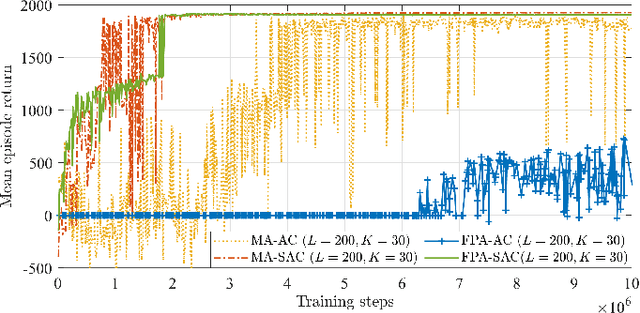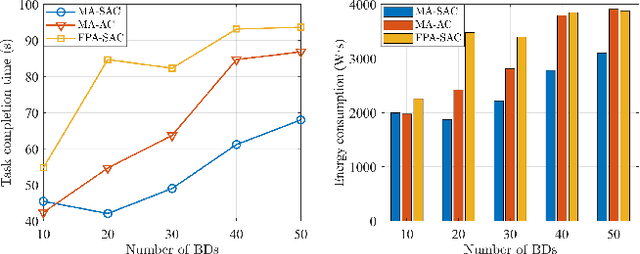Yu Bai
Beijing Friendship Hospital
AdaMHF: Adaptive Multimodal Hierarchical Fusion for Survival Prediction
Mar 27, 2025Abstract:The integration of pathologic images and genomic data for survival analysis has gained increasing attention with advances in multimodal learning. However, current methods often ignore biological characteristics, such as heterogeneity and sparsity, both within and across modalities, ultimately limiting their adaptability to clinical practice. To address these challenges, we propose AdaMHF: Adaptive Multimodal Hierarchical Fusion, a framework designed for efficient, comprehensive, and tailored feature extraction and fusion. AdaMHF is specifically adapted to the uniqueness of medical data, enabling accurate predictions with minimal resource consumption, even under challenging scenarios with missing modalities. Initially, AdaMHF employs an experts expansion and residual structure to activate specialized experts for extracting heterogeneous and sparse features. Extracted tokens undergo refinement via selection and aggregation, reducing the weight of non-dominant features while preserving comprehensive information. Subsequently, the encoded features are hierarchically fused, allowing multi-grained interactions across modalities to be captured. Furthermore, we introduce a survival prediction benchmark designed to resolve scenarios with missing modalities, mirroring real-world clinical conditions. Extensive experiments on TCGA datasets demonstrate that AdaMHF surpasses current state-of-the-art (SOTA) methods, showcasing exceptional performance in both complete and incomplete modality settings.
Being-0: A Humanoid Robotic Agent with Vision-Language Models and Modular Skills
Mar 16, 2025Abstract:Building autonomous robotic agents capable of achieving human-level performance in real-world embodied tasks is an ultimate goal in humanoid robot research. Recent advances have made significant progress in high-level cognition with Foundation Models (FMs) and low-level skill development for humanoid robots. However, directly combining these components often results in poor robustness and efficiency due to compounding errors in long-horizon tasks and the varied latency of different modules. We introduce Being-0, a hierarchical agent framework that integrates an FM with a modular skill library. The FM handles high-level cognitive tasks such as instruction understanding, task planning, and reasoning, while the skill library provides stable locomotion and dexterous manipulation for low-level control. To bridge the gap between these levels, we propose a novel Connector module, powered by a lightweight vision-language model (VLM). The Connector enhances the FM's embodied capabilities by translating language-based plans into actionable skill commands and dynamically coordinating locomotion and manipulation to improve task success. With all components, except the FM, deployable on low-cost onboard computation devices, Being-0 achieves efficient, real-time performance on a full-sized humanoid robot equipped with dexterous hands and active vision. Extensive experiments in large indoor environments demonstrate Being-0's effectiveness in solving complex, long-horizon tasks that require challenging navigation and manipulation subtasks. For further details and videos, visit https://beingbeyond.github.io/being-0.
Ground contact and reaction force sensing for linear policy control of quadruped robot
Mar 03, 2025Abstract:Designing robots capable of traversing uneven terrain and overcoming physical obstacles has been a longstanding challenge in the field of robotics. Walking robots show promise in this regard due to their agility, redundant DOFs and intermittent ground contact of locomoting appendages. However, the complexity of walking robots and their numerous DOFs make controlling them extremely difficult and computation heavy. Linear policies trained with reinforcement learning have been shown to perform adequately to enable quadrupedal walking, while being computationally light weight. The goal of this research is to study the effect of augmentation of observation space of a linear policy with newer state variables on performance of the policy. Since ground contact and reaction forces are the primary means of robot-environment interaction, they are essential state variables on which the linear policy must be informed. Experimental results show that augmenting the observation space with ground contact and reaction force data trains policies with better survivability, better stability against external disturbances and higher adaptability to untrained conditions.
DOEI: Dual Optimization of Embedding Information for Attention-Enhanced Class Activation Maps
Feb 21, 2025Abstract:Weakly supervised semantic segmentation (WSSS) typically utilizes limited semantic annotations to obtain initial Class Activation Maps (CAMs). However, due to the inadequate coupling between class activation responses and semantic information in high-dimensional space, the CAM is prone to object co-occurrence or under-activation, resulting in inferior recognition accuracy. To tackle this issue, we propose DOEI, Dual Optimization of Embedding Information, a novel approach that reconstructs embedding representations through semantic-aware attention weight matrices to optimize the expression capability of embedding information. Specifically, DOEI amplifies tokens with high confidence and suppresses those with low confidence during the class-to-patch interaction. This alignment of activation responses with semantic information strengthens the propagation and decoupling of target features, enabling the generated embeddings to more accurately represent target features in high-level semantic space. In addition, we propose a hybrid-feature alignment module in DOEI that combines RGB values, embedding-guided features, and self-attention weights to increase the reliability of candidate tokens. Comprehensive experiments show that DOEI is an effective plug-and-play module that empowers state-of-the-art visual transformer-based WSSS models to significantly improve the quality of CAMs and segmentation performance on popular benchmarks, including PASCAL VOC (+3.6%, +1.5%, +1.2% mIoU) and MS COCO (+1.2%, +1.6% mIoU). Code will be available at https://github.com/AIGeeksGroup/DOEI.
OpenAI o1 System Card
Dec 21, 2024



Abstract:The o1 model series is trained with large-scale reinforcement learning to reason using chain of thought. These advanced reasoning capabilities provide new avenues for improving the safety and robustness of our models. In particular, our models can reason about our safety policies in context when responding to potentially unsafe prompts, through deliberative alignment. This leads to state-of-the-art performance on certain benchmarks for risks such as generating illicit advice, choosing stereotyped responses, and succumbing to known jailbreaks. Training models to incorporate a chain of thought before answering has the potential to unlock substantial benefits, while also increasing potential risks that stem from heightened intelligence. Our results underscore the need for building robust alignment methods, extensively stress-testing their efficacy, and maintaining meticulous risk management protocols. This report outlines the safety work carried out for the OpenAI o1 and OpenAI o1-mini models, including safety evaluations, external red teaming, and Preparedness Framework evaluations.
StarWhisper Telescope: Agent-Based Observation Assistant System to Approach AI Astrophysicist
Dec 09, 2024



Abstract:With the rapid advancements in Large Language Models (LLMs), LLM-based agents have introduced convenient and user-friendly methods for leveraging tools across various domains. In the field of astronomical observation, the construction of new telescopes has significantly increased astronomers' workload. Deploying LLM-powered agents can effectively alleviate this burden and reduce the costs associated with training personnel. Within the Nearby Galaxy Supernovae Survey (NGSS) project, which encompasses eight telescopes across three observation sites, aiming to find the transients from the galaxies in 50 mpc, we have developed the \textbf{StarWhisper Telescope System} to manage the entire observation process. This system automates tasks such as generating observation lists, conducting observations, analyzing data, and providing feedback to the observer. Observation lists are customized for different sites and strategies to ensure comprehensive coverage of celestial objects. After manual verification, these lists are uploaded to the telescopes via the agents in the system, which initiates observations upon neutral language. The observed images are analyzed in real-time, and the transients are promptly communicated to the observer. The agent modifies them into a real-time follow-up observation proposal and send to the Xinglong observatory group chat, then add them to the next-day observation lists. Additionally, the integration of AI agents within the system provides online accessibility, saving astronomers' time and encouraging greater participation from amateur astronomers in the NGSS project.
Movable Antenna-Equipped UAV for Data Collection in Backscatter Sensor Networks: A Deep Reinforcement Learning-based Approach
Nov 21, 2024



Abstract:Backscatter communication (BC) becomes a promising energy-efficient solution for future wireless sensor networks (WSNs). Unmanned aerial vehicles (UAVs) enable flexible data collection from remote backscatter devices (BDs), yet conventional UAVs rely on omni-directional fixed-position antennas (FPAs), limiting channel gain and prolonging data collection time. To address this issue, we consider equipping a UAV with a directional movable antenna (MA) with high directivity and flexibility. The MA enhances channel gain by precisely aiming its main lobe at each BD, focusing transmission power for efficient communication. Our goal is to minimize the total data collection time by jointly optimizing the UAV's trajectory and the MA's orientation. We develop a deep reinforcement learning (DRL)-based strategy using the azimuth angle and distance between the UAV and each BD to simplify the agent's observation space. To ensure stability during training, we adopt Soft Actor-Critic (SAC) algorithm that balances exploration with reward maximization for efficient and reliable learning. Simulation results demonstrate that our proposed MA-equipped UAV with SAC outperforms both FPA-equipped UAVs and other RL methods, achieving significant reductions in both data collection time and energy consumption.
Active-Dormant Attention Heads: Mechanistically Demystifying Extreme-Token Phenomena in LLMs
Oct 17, 2024



Abstract:Practitioners have consistently observed three puzzling phenomena in transformer-based large language models (LLMs): attention sinks, value-state drains, and residual-state peaks, collectively referred to as extreme-token phenomena. These phenomena are characterized by certain so-called "sink tokens" receiving disproportionately high attention weights, exhibiting significantly smaller value states, and having much larger residual-state norms than those of other tokens. These extreme tokens give rise to various challenges in LLM inference, quantization, and interpretability. We elucidate the mechanisms behind extreme-token phenomena. First, we show that these phenomena arise in very simple architectures -- transformers with one to three layers -- trained on a toy model, the Bigram-Backcopy (BB) task. In this setting, we identify an active-dormant mechanism, where attention heads become sinks for specific input domains while remaining non-sinks for others. Our theoretical analysis of the training dynamics reveals that these phenomena are driven by a mutual reinforcement mechanism. Building on these insights, we propose strategies to mitigate extreme-token phenomena during pretraining, including replacing softmax with ReLU and Adam with SGD. Next, we extend our analysis to pretrained LLMs, including Llama and OLMo, showing that many attention heads exhibit a similar active-dormant mechanism as in the BB task, and that the mutual reinforcement mechanism also governs the emergence of extreme-token phenomena during LLM pretraining. Our results reveal that many of the static and dynamic properties of extreme-token phenomena predicted by the BB task align with observations in pretrained LLMs.
An Efficient Real-Time Object Detection Framework on Resource-Constricted Hardware Devices via Software and Hardware Co-design
Aug 20, 2024



Abstract:The fast development of object detection techniques has attracted attention to developing efficient Deep Neural Networks (DNNs). However, the current state-of-the-art DNN models can not provide a balanced solution among accuracy, speed, and model size. This paper proposes an efficient real-time object detection framework on resource-constrained hardware devices through hardware and software co-design. The Tensor Train (TT) decomposition is proposed for compressing the YOLOv5 model. By unitizing the unique characteristics given by the TT decomposition, we develop an efficient hardware accelerator based on FPGA devices. Experimental results show that the proposed method can significantly reduce the model size and improve the execution time.
MMRA: A Benchmark for Evaluating Multi-Granularity and Multi-Image Relational Association Capabilities in Large Visual Language Models
Aug 06, 2024



Abstract:Given the remarkable success that large visual language models (LVLMs) have achieved in image perception tasks, the endeavor to make LVLMs perceive the world like humans is drawing increasing attention. Current multi-modal benchmarks primarily focus on facts or specific topic-related knowledge contained within individual images. However, they often overlook the associative relations between multiple images, which require the identification and analysis of similarities among entities or content present in different images. Therefore, we propose the multi-image relation association task and a meticulously curated Multi-granularity Multi-image Relational Association (MMRA) benchmark, comprising 1,024 samples. In order to systematically and comprehensively evaluate current LVLMs, we establish an associational relation system among images that contain 11 subtasks (e.g, UsageSimilarity, SubEvent) at two granularity levels (i.e., image and entity) according to the relations in ConceptNet. Our experiments reveal that on the MMRA benchmark, current multi-image LVLMs exhibit distinct advantages and disadvantages across various subtasks. Notably, fine-grained, entity-level multi-image perception tasks pose a greater challenge for LVLMs compared to image-level tasks. Moreover, LVLMs perform poorly on spatial-related tasks, indicating that LVLMs still have limited spatial awareness. Additionally, our findings indicate that while LVLMs demonstrate a strong capability to perceive image details, enhancing their ability to associate information across multiple images hinges on improving the reasoning capabilities of their language model component. Moreover, we explored the ability of LVLMs to perceive image sequences within the context of our multi-image association task. Our experiments show that the majority of current LVLMs do not adequately model image sequences during the pre-training process.
 Add to Chrome
Add to Chrome Add to Firefox
Add to Firefox Add to Edge
Add to Edge